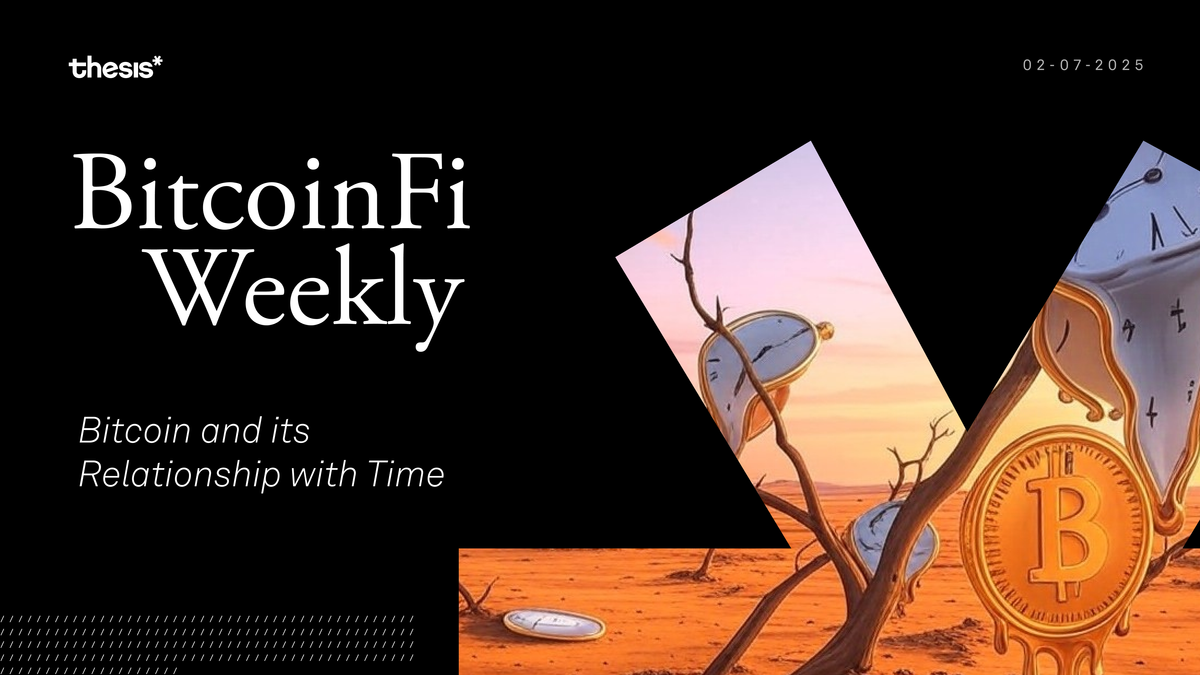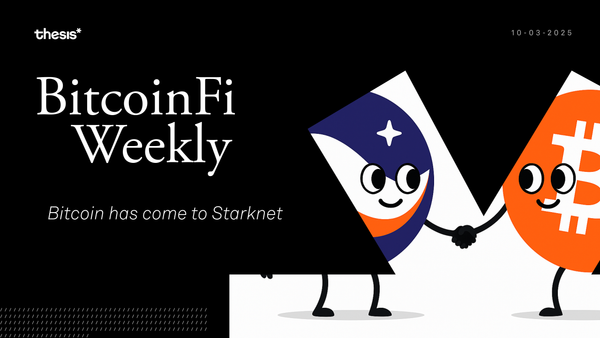Bitcoin and its Relationship with Time
We see in Bitcoin what we wish to see: a revolution, a folly, a technology, a philosophy, an investment, a warning, a hope. But no matter the shape of our expectations, Bitcoin continues, unmoved, its progress measured not in days or years but in blocks and confirmations.

Welcome to BitcoinFi Weekly. We cover where people use their BTC and what is changing in the Bitcoin world.
Time is weird. Bitcoin has been around long enough to have a history, but not long enough for anyone to agree on what that history means. To some, Bitcoin is still an experiment, its trajectory uncertain, its past a collection of disparate moments strung together by hindsight bias. To others, it's already inevitable, the logical endpoint of monetary evolution. The problem is that both views are shaped by time—our perception of it, our proximity to past events, and the narratives we construct to make sense of them. Bitcoin changes, but so does the way we remember it. The block size wars feel recent to some and ancient to others. The Taproot upgrade happened just over two years ago, yet discussions of further scripting improvements already feel like they belong to a different era. The longer you're in Bitcoin, the more you realize that the present is never quite as definitive as it seems.
Here’s this week’s rundown:
⏳ Feature Piece: The Shifting Perception of Bitcoin
🌱 Flashnet Announces Seed Round
🧪 Bitmosis: Osmosis adapts Bitcoin
🇸🇻 Has Bitcoin in El Salvador Failed?
Feature Piece: The Shifting Perception of Bitcoin
Bitcoin has been with us since 2009, and its story has already passed through several distinct phases. Despite only about 15 years of history, our minds compress or stretch that time in unexpected ways, creating a tapestry of distortions that make events seem closer or farther away than they really are. These illusions transform our relationship with technology, money, and really time itself.
When we look back at Bitcoin's early forum days—the conversations between Satoshi and Hal Finney, the pioneering discussions about mining on CPUs, the first real-world pizza transaction—it feels like peering into a different world. Those early Bitcoiners couldn't have imagined the ecosystem we have today, just as we can barely comprehend a time when the entire network could be mined on a laptop. Can those moments ever truly be experienced again? Obviously, we can still read the forum posts, verify the transactions onchain, but we can't recapture the raw curiosity and insatiable need for discovery of those early days. We're different people now, shaped by the intervening years of development, debate, and evolution.
Bitcoin and its Relationship with Time
The relationship between Bitcoin and time manifests in distinct eras, each marking a fundamental shift in understanding and implementation. Back in 2009 and 2010, Satoshi Nakamoto and a small group of supporters hashed out ideas on small, bitcoin forums. To anyone who joined Bitcoin in the past few years, those discussions sound like ancient history. But for those who were there, the back-and-forth felt significant and urgent. This gap in perception is a prime example of the chronocentric illusion—the belief that our personal standpoint in time is the real focal point.
Consider that the block size wars are now closer to Bitcoin's genesis block than to today. As someone who remembers the scaling debates feeling like yesterday, and remembers feeling at that time that Satoshi's disappearance was ancient history, this is deeply strange. This illusion shatters when you realize you've been in Bitcoin longer than some of the original core developers were when they first contributed. The temporal distance between different eras of Bitcoin development isn't static—it's constantly shifting, creating new perspectives and insights.
Bitcoin’s development is a continuous process of overlapping innovations and discoveries, rather than a set of distinct entities. We impose concepts on it: "The Forum Era," "The Mining Evolution," "The Block Wars," "The Renaissance." But when did these eras really happen? It's not like developers woke up one day and declared, "The Block Wars are over, now begins the Renaissance!"This leads to fascinating chronological illusions. At times, Bitcoin can feel fixed and unchanging, but in reality, it's continuously evolving. If you've been in the space for even a few years, you've witnessed fundamental shifts in how we understand and use Bitcoin—from the emergence of Lightning Network to the explosion of Bitcoin scripting.
This temporal distortion extends to how we view market cycles. We often speak of distinct "bull" and "bear" markets as if they were clearly delineated eras, but like all attempts to periodize time, these distinctions blur under closer inspection.
Zooming Out & the Price-Time Paradox
Perhaps nowhere is our distorted perception of time more evident than in Bitcoin's price action. When we're in the midst of market movements, our temporal experience becomes incredibly compressed. A week of sideways price action can feel like an eternity, while a sudden price drop can make months of gains feel ephemeral. We might call these micro-temporal illusions—our day-to-day experience of market time.
During periods of range-bound trading, each bounce between support and resistance carries emotional weight far beyond its long-term significance. A drop to the bottom of the range can trigger declarations of "the bear market is back," while a touch of the upper range has Twitter aflame with "the bull market is just getting started." We live these moments with intense immediacy.
When we zoom out, we perform an action that is literally looking at more time at once, and a completely different narrative emerges. Those ranges that felt like eternal prisons reveal themselves as trivial blips in a larger pattern. The "devastating" crashes and "explosive" rallies that consumed our daily attention smooth into gentle waves. All derived from the mere act of zooming out.
This shifting perspective reveals something profound about how we experience time in markets. When we're zoomed in, we're experiencing time differently. The emotional intensity of day-to-day trading creates a kind of temporal magnification, where each candle, each swing, and each moment carries outsized psychological weight.
The Future of Bitcoin Time
Bitcoin’s history is short in years, yet rich in events.
Reflecting on the now, its safe to say we live in a transitional period, but perhaps that's not quite the right way to think about it. Bitcoin has shown us that technological evolution, like price action, isn't linear—it's cyclical, recursive, and sometimes revolutionary. The so-called “Bitcoin Renaissance” we're experiencing now allows one to understand time itself differently. Just as zooming out on a price chart reveals patterns invisible in day-to-day movements, taking a longer view of Bitcoin's development reveals cycles of innovation, consolidation, and renewal.
So yes, make time to appreciate where we are in Bitcoin's journey. Be patient with development. Miss out on some trends. Fall behind on the latest proposals. Zoom out when the daily price action feels overwhelming. Feel time passing as you watch the ecosystem evolve. By recognizing the illusion of time, we gain a clearer grasp of Bitcoin’s actual progression—and we can better appreciate how each new chapter arises from a complex chain of moments that were all once now.
BitcoinFi Updates
Flashnet Announces Seed Round
Flashnet is introducing itself as the first permissionless, non-custodial, Bitcoin-native exchange designed to bring Bitcoin trading directly on-chain. They have successfully raised a $4.5 million seed round co-led by Abstract and other investors like UTXO, Soma Capital, HF0, and Chapter One.
Flashnet aims to tackle the Bitcoin custody paradox by settling directly on Bitcoin, eliminating counterparty risk, cutting costs, and offering “true permissionless trading” without extra consensus layers or bridging. The project leverages Spark, a new Bitcoin-native scaling solution, to achieve performance comparable to centralized exchanges while still settling on Bitcoin's base layer. Brale’s USDB stablecoin, the first of its kind on Bitcoin, is set to anchor trading pairs, while Privy will simplify the user experience for non-custodial wallets. However, little detail is known about the stablecoin or how Flashnet will work, as their docs are currently password-protected.
Bitmosis: Osmosis adapts Bitcoin
Osmosis is launching Bitmosis, a decentralized exchange for Bitcoin trading across different chains. Although Bitcoin stands as the largest cryptocurrency, it lacks a native decentralized exchange, leaving most BTC activity on slow, custodial platforms. To solve this, Bitmosis introduces "Alloyed BTC," a mechanism that unifies multiple Bitcoin variants (including those from Stacks, Merlin, and Rootstock) into a single liquid token, attempting to solve the fragmentation and fungibility issues that currently plague cross-chain Bitcoin trading. This would allow different Bitcoin representations to be treated as fungible within the exchange while maintaining user custody, similar to how centralized exchanges handle multiple USDC variants from different chains.
Bitmosis revealed several strategic components to drive adoption:
- Reduced trading fees (0.02% for BTC/USDC pairs)
- Zero-fee limit orders
- Positioning of BTC as the primary quote asset instead of OSMO
Additionally, Osmosis is actively accumulating Bitcoin through its protocol fees and ProtoRev module, with approximately $750,000 in BTC/USDC and BTC/ETH liquidity as of January 2025. This infrastructure aims to serve as a critical hub for Bitcoin L2s, enabling seamless cross-chain Bitcoin trading without requiring users to bridge back to the main Bitcoin network.
Has Bitcoin in El Salvador Failed?
El Salvador made history in 2021 as the first nation to adopt Bitcoin as legal tender. President Nayib Bukele championed the move, forecasting that it would boost financial inclusion for the many Salvadorans without bank access, streamline international remittances, and attract foreign investors to a tech-forward economy. The government introduced the Chivo wallet, installed Bitcoin ATMs, and even sketched out plans for a futuristic “Bitcoin City” powered by volcanic geothermal energy.
On the ground, however, widespread adoption has been elusive. Despite the legal requirement for businesses to accept Bitcoin and the lure of a free $30 Bitcoin bonus for those who downloaded the Chivo wallet, survey data shows that most Salvadorans remain hesitant. Technical issues with the app, general mistrust of the government, and confusion about how cryptocurrency works all contributed to lower-than-expected usage. Many who did download Chivo only redeemed the bonus and promptly abandoned it. Outside of a few hotspots like Bitcoin Beach in El Zonte, Bitcoin transactions are rare in everyday commerce. A study by Francisco Gavidia University found that 92% of Salvadorans do not use Bitcoin at all, a figure that has risen from the previous year.
At the same time, El Salvador continued to purchase Bitcoin for its reserves—now totaling more than 6,000 BTC. Meanwhile, the International Monetary Fund (IMF) has repeatedly flagged concerns that adopting such a volatile asset as legal tender poses threats to financial stability. After tense negotiations, the government signed a $1.4 billion loan deal with the IMF that included scaling back parts of the Bitcoin Law. As a result, paying taxes with BTC was phased out, and private businesses were no longer required to accept the cryptocurrency— making acceptance voluntary. The government has also indicated it might offload the Chivo wallet’s operations, allowing private digital wallets to fill that gap.
Despite these constraints, Bukele’s administration asserts that Bitcoin remains integral to El Salvador’s strategy. Officials say they still plan to keep buying Bitcoin, calling it part of a “Strategic Bitcoin Reserve.” Stacy Herbert of El Salvador’s National Bitcoin Office says the country may even increase its pace of acquisitions. Skeptics, however, note that large segments of the population continue to shun cryptocurrency, undermining the network effects necessary for it to become a mainstream payment method.
Research from economists at Yale SOM and the University of Chicago underscores why many Salvadorans aren’t embracing Bitcoin as hoped. It is not price volatility that deters them; it is concerns about trust, privacy, and technical hurdles. Even though digital currencies theoretically offer convenience and reduced transaction costs, a general wariness toward government-linked technology—combined with a lack of clear benefits—has discouraged further adoption. This would suggest that if other countries are looking to adopt similar solutions, they may face similar hurdles unless they can build robust trust and clarity around how a digital currency functions and why it is beneficial.
Closing Thoughts
And so, Bitcoin moves forward, indifferent to the illusions we place upon it. The years pass, narratives shift, convictions harden and dissolve, but the chain endures. Yet we, its observers, are bound by time, subject to the tides of sentiment and memory. We see in Bitcoin what we wish to see: a revolution, a folly, a technology, a philosophy, an investment, a warning, a hope. But no matter the shape of our expectations, Bitcoin continues, unmoved, its progress measured not in days or years but in blocks and confirmations. Perhaps that is the great lesson of it all. That in our ceaseless rush for meaning, our frantic attempts to categorize and contain, we miss the truth that was there all along—that time, like Bitcoin itself, does not bend to our desires. It moves forward, with or without us.
Thank you for tuning in to this week’s BitcoinFi Weekly. See you next week.
If there's a topic you’d like us to cover or have questions, reach out at [email protected].
Learn more about Thesis & Mezo at the following channels:
🧠 Thesis Hub: https://thesis.co/
👾 Discord: https://discord.mezo.org
🕊 X: https://twitter.com/MezoNetwork
🏦 Deposit Portal: https://mezo.org/hodl
ℹ️ Docs: https://info.mezo.org





